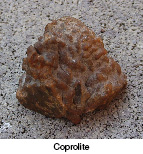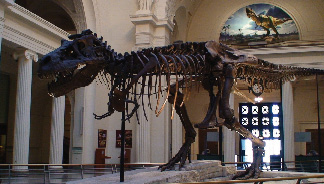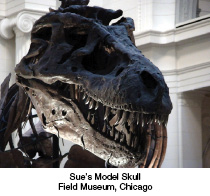

Our reason for discussing Sue is that dinosaurs capture the imagination of children and adults alike. Enormous numbers of questions come to us about dinosaurs, and religionists have made many false claims about dinosaurs. As more and more data on Sue is published, more questions are answered--and new ones are also generated. One of the themes we constantly promote in this journal is that science and the Bible are friends, not enemies. The more we know of the creation, the closer we get to the Creator. The Bible repeatedly tells us that we can know there is a God through the creation around us, and that God's wisdom can be seen in the heavens and on the earth (see Romans 1:19-22, Psalm 19, etc.). Man-made theories and human creeds will suffer in the face of new facts, but God's wisdom and design shines brighter and brighter as we learn the history of the cosmos. Truth is not only stranger than fiction, but it is stranger and more amazing than we can imagine.
 One of the amazing things about some dinosaurs is their
size. Sue is
42 feet long, 13 feet tall at the hips, and has teeth 7-1/2 to 12
inches
long. She would have weighed somewhere around seven tons when she was
alive. The skull is five feet long and would have weighed 600
pounds--in fact the head on the picture on our cover is a plastic
replica. The real skull is also on display at the Field Museum. The
problem was that if they put the skull on the skeleton with the steel
rods that hold the rest of Sue together the rods could not have held
the skull. If steel cannot handle the weight of the skull, imagine the
design required of bones and muscle to do so. Sue's brain was just over
1,000 cc--or roughly a quart. A human brain will be half again as
large. This animal was a machine, operating on instinct, not logical
thinking. Brain size does not always indicate intelligence, but a small
brain does put limitations on what an animal can do.
One of the amazing things about some dinosaurs is their
size. Sue is
42 feet long, 13 feet tall at the hips, and has teeth 7-1/2 to 12
inches
long. She would have weighed somewhere around seven tons when she was
alive. The skull is five feet long and would have weighed 600
pounds--in fact the head on the picture on our cover is a plastic
replica. The real skull is also on display at the Field Museum. The
problem was that if they put the skull on the skeleton with the steel
rods that hold the rest of Sue together the rods could not have held
the skull. If steel cannot handle the weight of the skull, imagine the
design required of bones and muscle to do so. Sue's brain was just over
1,000 cc--or roughly a quart. A human brain will be half again as
large. This animal was a machine, operating on instinct, not logical
thinking. Brain size does not always indicate intelligence, but a small
brain does put limitations on what an animal can do.
Because of the high quality of preservation of Sue, it has been possible to learn a great deal about how she lived. All studies of coprolite (fossilized excrement) from T. rex specimens indicate that they were meat eaters. The coprolite contains teeth of many dinosaurs, pieces of bone, skin, and other remains of animals that were eaten. Many of us have done the popular biology lab in which owl pellets are studied to see what the owls ate. With the dinosaurs there is no doubt that the T. rex was a 100 percent meat eater. This does not necessarily mean that T. rex was a hunter because scavengers also eat meat.
 When bones are preserved in good condition it is possible
to see
where muscles were attached. Looking at hip bones and hind limbs, we
can see the muscle placement. A basic rule of muscle physiology is that
the strength of a muscle increases by about two thirds as the mass of
the animal is doubled. For a dinosaur to run as portrayed in movies
like Jurassic Park, 86
percent of the body mass would have to be in the
leg muscles alone. Scientists have calculated that the maximum speed a
T. rex could run was about 11
mph. Sue walked with straight knees and
mostly ate carrion--dead animals. The huge plant-eating dinosaurs that
were on the earth at the time of the T.
rex created major waste
problems. God has always built ecosystems with animals that process
waste, and T. rex would serve
that role admirably.
When bones are preserved in good condition it is possible
to see
where muscles were attached. Looking at hip bones and hind limbs, we
can see the muscle placement. A basic rule of muscle physiology is that
the strength of a muscle increases by about two thirds as the mass of
the animal is doubled. For a dinosaur to run as portrayed in movies
like Jurassic Park, 86
percent of the body mass would have to be in the
leg muscles alone. Scientists have calculated that the maximum speed a
T. rex could run was about 11
mph. Sue walked with straight knees and
mostly ate carrion--dead animals. The huge plant-eating dinosaurs that
were on the earth at the time of the T.
rex created major waste
problems. God has always built ecosystems with animals that process
waste, and T. rex would serve
that role admirably.
One of the lessons that Sue and her contemporaries can teach us is that denominational theologies of death are not correct. Many denominations have taught that there was no such thing as death until Adam and Eve sinned. Statements in the Bible such as 1 Corinthians 15:21-22 which tell us that death entered through Adam are viewed as physical statements applying to all of life. One of the first problems that arises in this theology is that nothing can eat anything without death taking place. When you eat a plant or the fruit of a plant, things die. To produce the humus in soil, things must die. Those who promote the idea that nothing died until Adam and Eve sinned will usually say that animal death is what entered the world--not plant death. Cells in our bodies die regularly. In fact, outside of your brain, every cell in your body dies and is replaced roughly every seven years. What kind of animals would this include? Microscopic animals? How about worms? What about insects?
The problem here is that the subject of sin and Adam and Eve is a spiritual message, not a physical one. God had told Adam and Eve that "In the day you eat of it, you shall surely die" (Genesis 2:17). Did they drop dead physically when they ate of the forbidden fruit? Obviously not. Did they drop dead spiritually when they ate of the forbidden fruit? Absolutely! Jesus came to restore that spiritual life. Attempting to make the fall a physical thing with physical consequences creates a myriad of problems and contradictions because of a refusal to recognize the spiritual nature of man's separation from God.
Sue shows us clearly that animals were being eaten and animals were designed to eat those animals. Without that process, nature would have been out of balance very quickly. The result would have been catastrophic. X-rays of Sue show that she had two broken ribs, probably from confrontations with other dinosaurs. CT scans show clearly that Sue was designed for a carnivorous diet. The teeth were designed to cut meat and would not have worked to grind up grains. Her forelimbs had a serrated claw to cut meat into bite-size chunks.
 Another interesting find connected to Sue has fanned the
question of
whether the dinosaurs are related to birds. For the first time a
wishbone (or furcula) was found intact in Sue. While this does not
prove dinosaurs were birds, it is a find that might support that view.
This raises a good demonstration of the credibility of the biblical
account. In the Bible, the taxonomic classifications are very general.
The Hebrew word min is used
for kind, and its use is very consistent in
Genesis 1 and Genesis 6 in the flood account. In all of these cases and
in 1
Corinthians 15:39, four kinds of flesh are identified--the flesh of
fish, the flesh of birds, the flesh of beasts, and the flesh of man.
The flesh of fish would include fish, amphibians, and reptiles--all of
whom are cold blooded, have scales, and very similar anatomical
structure. The flesh of birds is very different, but would include all
kinds of birds including some, like Darwin's finches, who have
developed in recent times. As scientists
Another interesting find connected to Sue has fanned the
question of
whether the dinosaurs are related to birds. For the first time a
wishbone (or furcula) was found intact in Sue. While this does not
prove dinosaurs were birds, it is a find that might support that view.
This raises a good demonstration of the credibility of the biblical
account. In the Bible, the taxonomic classifications are very general.
The Hebrew word min is used
for kind, and its use is very consistent in
Genesis 1 and Genesis 6 in the flood account. In all of these cases and
in 1
Corinthians 15:39, four kinds of flesh are identified--the flesh of
fish, the flesh of birds, the flesh of beasts, and the flesh of man.
The flesh of fish would include fish, amphibians, and reptiles--all of
whom are cold blooded, have scales, and very similar anatomical
structure. The flesh of birds is very different, but would include all
kinds of birds including some, like Darwin's finches, who have
developed in recent times. As scientists  debate
whether dinosaurs are
birds or reptiles, or fall into a grouping of their own, we have to be
reminded of the incredible wisdom and accuracy of the Bible whose four
groups of flesh will accommodate dinosaurs no matter what scientists
decide. This is an interesting question, and we will all be fascinated
to see how it turns out. Sue shows us that design and planning has
preceded us on this planet. Its incredible complexity serves to impress
us with the Designer who planned it all long before man was on the
scene.
debate
whether dinosaurs are
birds or reptiles, or fall into a grouping of their own, we have to be
reminded of the incredible wisdom and accuracy of the Bible whose four
groups of flesh will accommodate dinosaurs no matter what scientists
decide. This is an interesting question, and we will all be fascinated
to see how it turns out. Sue shows us that design and planning has
preceded us on this planet. Its incredible complexity serves to impress
us with the Designer who planned it all long before man was on the
scene.
Let our children enjoy dinosaurs and be enthralled with how they lived, how big they were, and what their role was in preparing the earth for man. Let us not create tabloid-mentality images of babies riding on the back of a T. rex as it happily munches grass. Sue and her contemporaries were not playmates of man and did not exist when Adam and Eve were on the earth. The animals of Job 38-41 were not dinosaurs, but they too served man and were a part of his history. That story will be taken up in another discussion.
Back to Contents Does God Exist?, JanFeb09.